Web Infantry Equipment, Pattern 1937
Officers' and Pistol Accoutrements
Stores Ref. A1/AA 0611 Case, binocular, W.E. Patt. ‘37 Updated!
Stores Ref. CN/AA 0611 Web Equipment, Patt. ’37, Case, binocular


 The Case, binocular, W.E. Patt. '37 was yet another old design, this stemming from later production standard of the Web Equipment for Officers (W.E.O.), where the simple flap lid was changed to a box lid. Where the W.E.O. used Binocular cases stitched to Compass pockets, Patt. ’37 borrowed from Web Equipment, Royal Artillery (W.E., R.A.), where these two items were made separately and connected by a brass “C” clip, stitched transversely above the two belt hooks. W.E.O. provided a number of different sizes of Case, but Patt. ’37 was designed solely for the Binocular, prismatic, No. 2, an 8 x 30 design. There was an inner and outer layer of thin webbing, between which was a fibreboard stiffener. The example shown here is maker marked "M.E. Co." and dated 1937. The photo below right below shows Canadian officers in training (or at least posing for the camera), wearing W.E. Patt. '37 Officers' Web Equipment. Both variations of the Binocular case are visible. From the Steve Britton Collection, photographs © Steve Britton 2019.
The Case, binocular, W.E. Patt. '37 was yet another old design, this stemming from later production standard of the Web Equipment for Officers (W.E.O.), where the simple flap lid was changed to a box lid. Where the W.E.O. used Binocular cases stitched to Compass pockets, Patt. ’37 borrowed from Web Equipment, Royal Artillery (W.E., R.A.), where these two items were made separately and connected by a brass “C” clip, stitched transversely above the two belt hooks. W.E.O. provided a number of different sizes of Case, but Patt. ’37 was designed solely for the Binocular, prismatic, No. 2, an 8 x 30 design. There was an inner and outer layer of thin webbing, between which was a fibreboard stiffener. The example shown here is maker marked "M.E. Co." and dated 1937. The photo below right below shows Canadian officers in training (or at least posing for the camera), wearing W.E. Patt. '37 Officers' Web Equipment. Both variations of the Binocular case are visible. From the Steve Britton Collection, photographs © Steve Britton 2019.

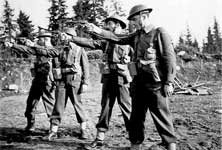 List of Changes entry No. L. of C. §B4510 (date t.b.d.) provided a rather pointless bit of “gold-plating”. It introduced a Carrier, Case, binocular, W.E. Patt. ’37, which is slightly misleading, as it should have read Carrier, for Case, binocular, W.E. Patt. ’37. As the Carrier was not part of Patt. ’37, it is described under Associated Equipment. Shown left is another first issue Binocular case, this time in its Carrier. This example is from the Ed Storey Collection, photograph © Ed Storey 2007.
List of Changes entry No. L. of C. §B4510 (date t.b.d.) provided a rather pointless bit of “gold-plating”. It introduced a Carrier, Case, binocular, W.E. Patt. ’37, which is slightly misleading, as it should have read Carrier, for Case, binocular, W.E. Patt. ’37. As the Carrier was not part of Patt. ’37, it is described under Associated Equipment. Shown left is another first issue Binocular case, this time in its Carrier. This example is from the Ed Storey Collection, photograph © Ed Storey 2007.
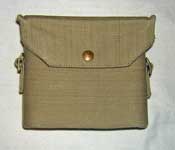

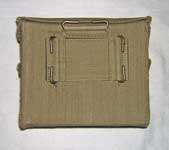 When common sense prevailed, A.C.I. 580/1941 provided for a modification to existing Cases, with new production being made to the modified standard. A pair of 1-inch buckles and chapes were riveted to the case body, one on each side, which allowed a Brace to be used as a sling. The A.C.I. added that officers could indent for an additional Brace, right, long, W.E. Patt. ’37 to save dismantling their web sets. A.C.I. 899/1941 authorised one Brace, right, long for each modified Case held as unit equipment. Manufacture thereafter was always with the side buckles.The second issue Case shown here, with 1-inch side buckles, is maker marked "M.E. Co." and dated 1941. From the Karkee Web Collection.
When common sense prevailed, A.C.I. 580/1941 provided for a modification to existing Cases, with new production being made to the modified standard. A pair of 1-inch buckles and chapes were riveted to the case body, one on each side, which allowed a Brace to be used as a sling. The A.C.I. added that officers could indent for an additional Brace, right, long, W.E. Patt. ’37 to save dismantling their web sets. A.C.I. 899/1941 authorised one Brace, right, long for each modified Case held as unit equipment. Manufacture thereafter was always with the side buckles.The second issue Case shown here, with 1-inch side buckles, is maker marked "M.E. Co." and dated 1941. From the Karkee Web Collection.
 Three different versions of the Case, binocular, W.E. Patt. '37. At far left is the first issue Case without side buckles and chapes. The Case at center left has 1-inch buckles and chapes riveted to the case body as specified in A.C.I. 580/1941. Finally, the Case near left is a second issue, with its side buckles and chapes sewn to the body. From the David Gordon Collection, photograph David Gordon 2009.
Three different versions of the Case, binocular, W.E. Patt. '37. At far left is the first issue Case without side buckles and chapes. The Case at center left has 1-inch buckles and chapes riveted to the case body as specified in A.C.I. 580/1941. Finally, the Case near left is a second issue, with its side buckles and chapes sewn to the body. From the David Gordon Collection, photograph David Gordon 2009.
Devotees of the BBC TV classic, Dad’s Army will have noted Binocular cases (of various sizes, to the eagle-eyed) being used as stand-ins for the correct Pouches, ammunition (Home Guard Pattern). Whilst this was expedient for the Wardrobe Department, it was incorrect. However, the Case was used in a different role, which involved a wooden internal frame, so that the Nos. 1 and 2 optical sights for the 2-inch Mortar could be carried securely.
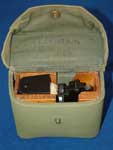
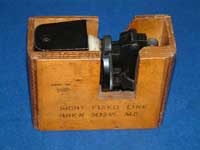
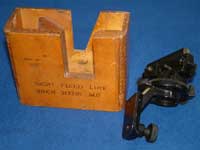 Karkee Web contributors Kevin Groom and Tom Ready have pointed out another use for the Case, into which CM 1146 Frame, Housing Fixed Line Sight, .303-in. Bren M.G., Mark. I was fitted. This was a wooden box, radiussed to fit the Case, for the sight used in the S.F. (Sustained Fire) role, only when the Bren was on the Mounting, tripod, Bren .303-in. M.G., Mark. I. On early supplies of Mark I, there was a second tapered dovetail, on the left side of the Receiver, ahead of the drum sight, into which the FLS was fitted.From the collection of Kevin Groom. Photographs © Kevin Groom 2009
Karkee Web contributors Kevin Groom and Tom Ready have pointed out another use for the Case, into which CM 1146 Frame, Housing Fixed Line Sight, .303-in. Bren M.G., Mark. I was fitted. This was a wooden box, radiussed to fit the Case, for the sight used in the S.F. (Sustained Fire) role, only when the Bren was on the Mounting, tripod, Bren .303-in. M.G., Mark. I. On early supplies of Mark I, there was a second tapered dovetail, on the left side of the Receiver, ahead of the drum sight, into which the FLS was fitted.From the collection of Kevin Groom. Photographs © Kevin Groom 2009

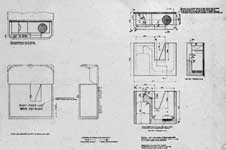 Left - another photo from Kevin Groom's collection, showing the Fixed Line Sight mounted on a Bren. At left, a detail from a fabrication drawing of the Frame and Case.
Left - another photo from Kevin Groom's collection, showing the Fixed Line Sight mounted on a Bren. At left, a detail from a fabrication drawing of the Frame and Case.
Stores Ref. A1/AA 1441 Pocket, compass, W.E. Patt. ‘37
Stores Ref. CN/AA 1441 Web Equipment, Patt. ’37, Pocket, compass

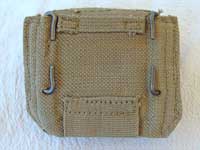
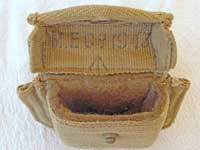 Borrowed from W.E.O. and W.E., R.A., this was an integrally woven pistol ammunition pocket, with a bellows base gusset , but lined with thick felt. As with the R.A. pattern, a transverse narrow web loop was stitched at the top, with a thin web fairway stitched to the base and the usual belt hooks. The loop located behind the "Loop, rectangular" of the Brace attachment and was retained there by the Brace being passed through the brass loop, over the web loop and back through the brass loop. The transverse “C” clip, on top of the Binocular case, was hooked into the web fairway on the Compass pocket. In the detail picture near left you can see the felt lining that protects the compass. This example is maker marked "M.E. Co." and dated 1943. From the Terry Hawker Collection, photos © Terry Hawker 2009.
Borrowed from W.E.O. and W.E., R.A., this was an integrally woven pistol ammunition pocket, with a bellows base gusset , but lined with thick felt. As with the R.A. pattern, a transverse narrow web loop was stitched at the top, with a thin web fairway stitched to the base and the usual belt hooks. The loop located behind the "Loop, rectangular" of the Brace attachment and was retained there by the Brace being passed through the brass loop, over the web loop and back through the brass loop. The transverse “C” clip, on top of the Binocular case, was hooked into the web fairway on the Compass pocket. In the detail picture near left you can see the felt lining that protects the compass. This example is maker marked "M.E. Co." and dated 1943. From the Terry Hawker Collection, photos © Terry Hawker 2009.
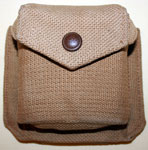
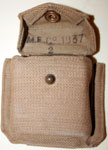
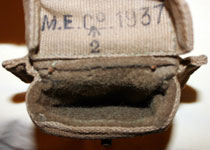
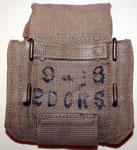 This very early example is maker marked "M.E. Co." and dated 1937. From the Collection of militaria dealer Steve Britton of the Britton at War website. According to Steve, this is part of what he believes to have been a sample set issued to the 2nd Dorset Regiment in September, 1938. The other pieces of the partial set are all dated 1938. Photos © Steve Britton 2013.
This very early example is maker marked "M.E. Co." and dated 1937. From the Collection of militaria dealer Steve Britton of the Britton at War website. According to Steve, this is part of what he believes to have been a sample set issued to the 2nd Dorset Regiment in September, 1938. The other pieces of the partial set are all dated 1938. Photos © Steve Britton 2013.
Stores Ref. A1/AA 1483 Pouch, ammunition, pistol, W.E. Patt. ‘37
Stores Ref. CN/AA 1483 Web Equipment, Patt. ’37, Pouch, ammunition, pistol
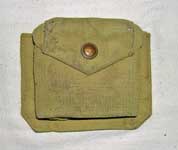

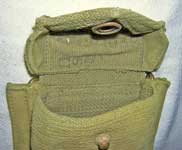 The Pouch, ammunition, pistol, W.E. Patt. ‘37, was an exact replica of the Compass pocket, with the felt lining omitted. It was intended to carry 12 rounds of .38-in. ammunition and could be connected to the Case, pistol in the same way as the Case, binoculars and Pocket, compass were. The connected assembly was often worn with the Pouch hooked to the belt, the Pistol case hanging lower down. The khaki blancoed example shown here is maker marked "M.E. Co." and dated 1939. From the Karkee Web Collection.
The Pouch, ammunition, pistol, W.E. Patt. ‘37, was an exact replica of the Compass pocket, with the felt lining omitted. It was intended to carry 12 rounds of .38-in. ammunition and could be connected to the Case, pistol in the same way as the Case, binoculars and Pocket, compass were. The connected assembly was often worn with the Pouch hooked to the belt, the Pistol case hanging lower down. The khaki blancoed example shown here is maker marked "M.E. Co." and dated 1939. From the Karkee Web Collection.
Stores Ref. A1/AA 0658 Case, pistol, W.E. Patt. ‘37
Stores Ref. CN/AA 0658 Web Equipment, Patt. ’37, Case, pistol
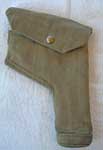

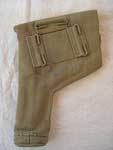 Only one holster was listed and this was a re-work of the 1935 .38-in holster introduced for use with Patt. ’08 W.E., though even this holster as origins as far back as Patt. ’19 W.E. The reverse face had two “C” clips for the belt, with a third mounted transversely, for connection to the Pouch, ammunition, pistol. The calibre of pistol - .38-in. - was not detailed until the 1939 instructional pamphlet was issued, but this also stated that a .455-in. pistol would fit. This was not the most elegant fit, as witness a Mark VI Webley in the holster for Patt. ’08. The example shown left is maker marked "M.E. Co." and dated 1942. From the Terry Hawker Collection, photos © Terry Hawker 2009.
Only one holster was listed and this was a re-work of the 1935 .38-in holster introduced for use with Patt. ’08 W.E., though even this holster as origins as far back as Patt. ’19 W.E. The reverse face had two “C” clips for the belt, with a third mounted transversely, for connection to the Pouch, ammunition, pistol. The calibre of pistol - .38-in. - was not detailed until the 1939 instructional pamphlet was issued, but this also stated that a .455-in. pistol would fit. This was not the most elegant fit, as witness a Mark VI Webley in the holster for Patt. ’08. The example shown left is maker marked "M.E. Co." and dated 1942. From the Terry Hawker Collection, photos © Terry Hawker 2009.
The holster is a triumph of Mills’ integral weaving, being made as two conjoined, closed tubes of different sizes. Since two diameters obviously cannot mate completely, the remaining open portion was turned in and stitched, forming the slanted section under the trigger guard. The flap was woven as an extension and had a Crown Half press stud, off-set to the right of centre, which ensured that the flap closed on a diagonal fold. The Spigot half of the press fastener was mounted centrally on the holster body. A narrow web sleeve, called a “loop” in Army parlance, was stitched down the inside, parallel to the barrel side. This was for the cleaning rod. The whole holster was lined with a second layer of webbing, which served also to prevent the rear side of the spigot half marking the pistol, as this is fixed only through the outer layer of webbing.
On the standard holster, the lower edge of the closed flap was parallel to the slanted and stitched edge. However, on some holsters the folded edge of the flap is almost square to the long side of the holster. It was accepted that these were for the.45-in. Colt Automatic pistol, even though not one piece of Army documentation has yet been seen. On preparing this write-up, part of KWRT became un-convinced that this was so! We were suddenly faced with .38-in revolvers not fitting the holster designed for it. We also had Colt Autos not fitting the standard holster - which they should - being smaller than the Pistol, revolver, No. 2.
It is not helpful that not one single official document has been seen, with reference, let alone a hint, of a special-to-type holster for the Colt Auto. Though a lack of documentation does not, in itself, prove it did not exist, KWRT are evenly divided. Part feel the “squared” holsters are a result of expedient, but relaxed Quality Control. Others still believe the “squared” design to have been deliberate. One has advanced the thought that the overall size of holsters was perhaps tweaked, as the War progressed, simply to contend with whatever pistol might require carriage. There is no doubt that the Colt Auto was used – the question being in what was it carried?!
KW therefore needs your help. We need holster photographs, open (to show markings and press fastener component positioning) and closed to show if the flap folds on a diagonal or perpendicular line to the holster body. The more photos, the better can be the attempt to make sense of these variants.
Other manufacturing variants, both from U.K. and Empire manufacturers will be covered in a future phase, but the above request will also prove most useful to more properly evaluate variations, hopefully on a company-by-company basis - if the sample proves large enough...
Stores Ref. A1/AA 0661 Case, pistol, web, R.A.C. Mk. II
Stores Ref. CN/AA 0661 Web Equipment, Patt. ’37, Case, pistol, web, R.A.C. Mk. II

 The Case, pistol, web, R.T.C. is dealt with under the Patt. ’08 W.E. section. The 1939 instructional pamphlet added in a Pistol Case with Cartridge Loops on P.5, but then refers to it as Pistol Case R.A.C. on P.8. Neither of these were correct nomenclatures, moreover the Case was still not designated as “Patt. ’37 W.E.” in the V.A.O.S. and, in the event, it never gained this nomenclature. It is therefore covered separately in Associated Equipment.
The Case, pistol, web, R.T.C. is dealt with under the Patt. ’08 W.E. section. The 1939 instructional pamphlet added in a Pistol Case with Cartridge Loops on P.5, but then refers to it as Pistol Case R.A.C. on P.8. Neither of these were correct nomenclatures, moreover the Case was still not designated as “Patt. ’37 W.E.” in the V.A.O.S. and, in the event, it never gained this nomenclature. It is therefore covered separately in Associated Equipment.
L. of C. §B7399, which was approved on 18 January, 1943, made the R.A.C. Case and its two sizes of Leg strap obsolescent. All stocks were to be shortened in accordance with A.C.I. 2662/1942. The L. of C. went on to state that “…eventually all R.A.C. personnel will be issued with Cat. No. AA 0658 Case, pistol, W.E., Pn. ’37…”. This was the standard, flapped pattern of holster. In the event, there was evidently a re-think and L. of C. §B8686, approved 27 October, 1943, introduced the Mark II Case and changed the nomenclature of the original R.A.C. Case, all of which should now be of the shortened form! These would now be Cases, pistol, web, R.A.C. Mk. I, together with the two sizes of Leg strap.
The Mark II, still an open-topped holster, was now provided with two belt loops, described as “…With loop and fairway, for carriage…on, or below the belt…”. The nomenclature above - still without “Patt. ’37 W.E.” - survived until 1951, when L. of C. §C4686 absorbed it into the Pattern, still as Mark II, where it ought to have been Mk. 2, Arabic Numbers having been adopted some years prior. In the 1950s, the metal fittings were Bonderised, a chemically induced mat black finish. Although intended for the .38-in. Enfield Pistol No. 2, in conversation with the writer, a wartime R.T.R. man, who had served in the Western Desert, recalled being issued with a .32-in. automatic pistol. He could not recall the make (Browning perhaps?), but they were worn in the R.A.C. pistol cases. The example shown here is maker marked "M.W. & S. Ltd." and dated 1959. From the Terry Hawker Collection. Photographs © 2009 Terry Hawker.
Stores Ref. (unknown) Case, pistol, automatic, W.E. Patt. ’37
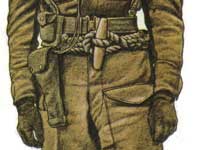 Another design has been noted, nomenclature and stores code unknown. This is similar to Patt. 37, but is closed with two press studs. Since the flap is square to the body, it is assumed to contain an automatic pistol. It is shown suspended from a Patt. ’37 Pistol ammunition pocket, so the rear of the Holster must be fitted up as Patt. ’37. This detail has been noted in a painting made from a photograph of a Free French Commando. KW would welcome details of the original photo or, better yet, an actual example!
Another design has been noted, nomenclature and stores code unknown. This is similar to Patt. 37, but is closed with two press studs. Since the flap is square to the body, it is assumed to contain an automatic pistol. It is shown suspended from a Patt. ’37 Pistol ammunition pocket, so the rear of the Holster must be fitted up as Patt. ’37. This detail has been noted in a painting made from a photograph of a Free French Commando. KW would welcome details of the original photo or, better yet, an actual example!
Stores Ref. B3 / BC / C / 10004 Holster, C, No. 2 9-mm. pistol, Browning (FN), C, Mk. 2
Stores Ref. B3 / CGB 7146 Holster, 9-mm. Browning Pistol, “C” No. 2. Mk. 2
Stores Ref. CN / CGB / 7146 Holster, webbing, No. 2, Mk. 2
Stores Ref. 1095-21-103-6512 Web Equipment, Patt. ’37, Holster, pistol
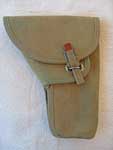
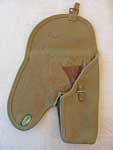
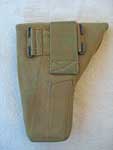 The first mention of this Holster came in L. of C. §C1918, approved on 11 Jul, 1945. This notified the approval of both a Canadian specification and drawings, “…to govern the manufacture…” of this Holster. However, it ended with the comment that only Canadian manufacture was being undertaken “…at present…”. The separation of “Number” and “Mark” is unhelpful, as it gives the impression of a Pistol Mark 2.
The first mention of this Holster came in L. of C. §C1918, approved on 11 Jul, 1945. This notified the approval of both a Canadian specification and drawings, “…to govern the manufacture…” of this Holster. However, it ended with the comment that only Canadian manufacture was being undertaken “…at present…”. The separation of “Number” and “Mark” is unhelpful, as it gives the impression of a Pistol Mark 2.
The new Holster was a complete re-design of the Mark 1 design, instigated by the Chinese. It now had a flap that closed, on a diagonal fold, across a much more open holster body. This flap had a brass reinforced slot, fitting over a staple. The main flap closed downwards, fastening over the same staple. A metal liner was positioned next to the underside of the weapon, holding one magazine, again closed off by a side-hinged flap. Here the similarity ended, as the liner was parallel to the barrel, the holster body being parallel sided. The rear was fitted with two standard “C” clips for attachment to a Patt. ’37 Waist belt. A half-standing belt loop was positioned between the hooks, over the patch holding the hooks. Inside, there was a leather sleeve, with a funnel mouth, to contain a cleaning rod. The example shown above left is maker marked "Z.L. & T. Ltd." and dated 1945. From the Terry Hawker Collection, photos © Terry Hawker 2009.
The September 1946 edition of V.A.O.S. Section B3, qualified as a Composite List, showed the new Holster, now with a revised B3 code of CGB 7146 alongside the Holster, No. 2, Mk 1, Arabic numbering now in use for Marks. The nomenclature was now better rendered as “No. 2, Mk. 2” and cross reference was made to the original 10004 code. Comment was added “…interchange with CGB 7190…”, which was the Holster No. 2, Mk. 1.
 At this stage, it was still “N.I.V.”, which was rectified by L. of C. §C6789, approved on 14 Jul, 1955, confirming the shorter 7146 code and transferring it and the Mark 1 from Section B3 to C.C.N. Section CN, which was the old V.A.O.S. Section A1, re-vamped by C 4686 in 1951. By this time, U.K. manufactured items, coded as CN / CGB / B 7146, were in existence. These were in softer webbing than Canadian examples and had a webbing cleaning rod sleeve, where Canadian versions had leather sleeves. The resin impregnated strap tips for the Q.R. buckle had also changed to the doubled and stitched U.K. version. Shown left are Canadian (far left) and British (near left) issued of this Holster. The Canadian example is maker marked "Z.L. & T. Ltd." and dated 1945. The British Holster is maker marked "M" and dated 1957. From the Carl Woods Collection, photos © Carl Woods 2009.
At this stage, it was still “N.I.V.”, which was rectified by L. of C. §C6789, approved on 14 Jul, 1955, confirming the shorter 7146 code and transferring it and the Mark 1 from Section B3 to C.C.N. Section CN, which was the old V.A.O.S. Section A1, re-vamped by C 4686 in 1951. By this time, U.K. manufactured items, coded as CN / CGB / B 7146, were in existence. These were in softer webbing than Canadian examples and had a webbing cleaning rod sleeve, where Canadian versions had leather sleeves. The resin impregnated strap tips for the Q.R. buckle had also changed to the doubled and stitched U.K. version. Shown left are Canadian (far left) and British (near left) issued of this Holster. The Canadian example is maker marked "Z.L. & T. Ltd." and dated 1945. The British Holster is maker marked "M" and dated 1957. From the Carl Woods Collection, photos © Carl Woods 2009.
The 1960 edition of C.C.N. Section CN had the Mark 2 under Miscellaneous, but in the 1965 edition, the No. 2, Mk. 2 Holster had been moved to Web Equipment, Patt. ’37, simplified still further to just Holster, pistol. Under Details were Pistol, automatic 9mm. F.N. Browning, No. 1, Mk. 1 and Mk. 1*, No. 2 Mk. 1 and Mk. 1*. It appears after CN 0658 Case, pistol and CN 0661 Case, web, R.A.C., Mk. 2. The distinction between a “Case” and a “Holster” seems to be a case of semantics. Self-evidently, it was designed for Patt. ’37 but, for 19 years, it did not have that nomenclature. What is of interest is the new stores code for the Holster, which was a N.A.T.O. Stores Number, still a rarity in the 1965 CN list. The “21” was the Nation Code for Canada, where the Holster had been designed, but not necessarily manufactured.
The Mark 2 Holster had vanished from C.O.S.A. listings by 1976, but it lived on, slightly modified and now in green, as CN 1095-99-120-4509 Web Equipment Patt. ’58 Holster, pistol. The R.A.F. used blue-grey and white versions, but attached to Patt. ’37 W.E.


 The Case, binocular, W.E. Patt. '37 was yet another old design, this stemming from later production standard of the Web Equipment for Officers (W.E.O.), where the simple flap lid was changed to a box lid. Where the W.E.O. used Binocular cases stitched to Compass pockets, Patt. ’37 borrowed from Web Equipment, Royal Artillery (W.E., R.A.), where these two items were made separately and connected by a brass “C” clip, stitched transversely above the two belt hooks. W.E.O. provided a number of different sizes of Case, but Patt. ’37 was designed solely for the Binocular, prismatic, No. 2, an 8 x 30 design. There was an inner and outer layer of thin webbing, between which was a fibreboard stiffener. The example shown here is maker marked "M.E. Co." and dated 1937. The photo below right below shows Canadian officers in training (or at least posing for the camera), wearing W.E. Patt. '37 Officers' Web Equipment. Both variations of the Binocular case are visible. From the Steve Britton Collection, photographs © Steve Britton 2019.
The Case, binocular, W.E. Patt. '37 was yet another old design, this stemming from later production standard of the Web Equipment for Officers (W.E.O.), where the simple flap lid was changed to a box lid. Where the W.E.O. used Binocular cases stitched to Compass pockets, Patt. ’37 borrowed from Web Equipment, Royal Artillery (W.E., R.A.), where these two items were made separately and connected by a brass “C” clip, stitched transversely above the two belt hooks. W.E.O. provided a number of different sizes of Case, but Patt. ’37 was designed solely for the Binocular, prismatic, No. 2, an 8 x 30 design. There was an inner and outer layer of thin webbing, between which was a fibreboard stiffener. The example shown here is maker marked "M.E. Co." and dated 1937. The photo below right below shows Canadian officers in training (or at least posing for the camera), wearing W.E. Patt. '37 Officers' Web Equipment. Both variations of the Binocular case are visible. From the Steve Britton Collection, photographs © Steve Britton 2019.
 List of Changes entry No. L. of C. §B4510 (date t.b.d.) provided a rather pointless bit of “gold-plating”. It introduced a Carrier, Case, binocular, W.E. Patt. ’37, which is slightly misleading, as it should have read Carrier, for Case, binocular, W.E. Patt. ’37. As the Carrier was not part of Patt. ’37, it is described under Associated Equipment. Shown left is another first issue Binocular case, this time in its Carrier. This example is from the Ed Storey Collection, photograph © Ed Storey 2007.
List of Changes entry No. L. of C. §B4510 (date t.b.d.) provided a rather pointless bit of “gold-plating”. It introduced a Carrier, Case, binocular, W.E. Patt. ’37, which is slightly misleading, as it should have read Carrier, for Case, binocular, W.E. Patt. ’37. As the Carrier was not part of Patt. ’37, it is described under Associated Equipment. Shown left is another first issue Binocular case, this time in its Carrier. This example is from the Ed Storey Collection, photograph © Ed Storey 2007.

 When common sense prevailed, A.C.I. 580/1941 provided for a modification to existing Cases, with new production being made to the modified standard. A pair of 1-inch buckles and chapes were riveted to the case body, one on each side, which allowed a Brace to be used as a sling. The A.C.I. added that officers could indent for an additional Brace, right, long, W.E. Patt. ’37 to save dismantling their web sets. A.C.I. 899/1941 authorised one Brace, right, long for each modified Case held as unit equipment. Manufacture thereafter was always with the side buckles.The second issue Case shown here, with 1-inch side buckles, is maker marked "M.E. Co." and dated 1941. From the Karkee Web Collection.
When common sense prevailed, A.C.I. 580/1941 provided for a modification to existing Cases, with new production being made to the modified standard. A pair of 1-inch buckles and chapes were riveted to the case body, one on each side, which allowed a Brace to be used as a sling. The A.C.I. added that officers could indent for an additional Brace, right, long, W.E. Patt. ’37 to save dismantling their web sets. A.C.I. 899/1941 authorised one Brace, right, long for each modified Case held as unit equipment. Manufacture thereafter was always with the side buckles.The second issue Case shown here, with 1-inch side buckles, is maker marked "M.E. Co." and dated 1941. From the Karkee Web Collection. Three different versions of the Case, binocular, W.E. Patt. '37. At far left is the first issue Case without side buckles and chapes. The Case at center left has 1-inch buckles and chapes riveted to the case body as specified in A.C.I. 580/1941. Finally, the Case near left is a second issue, with its side buckles and chapes sewn to the body. From the David Gordon Collection, photograph David Gordon 2009.
Three different versions of the Case, binocular, W.E. Patt. '37. At far left is the first issue Case without side buckles and chapes. The Case at center left has 1-inch buckles and chapes riveted to the case body as specified in A.C.I. 580/1941. Finally, the Case near left is a second issue, with its side buckles and chapes sewn to the body. From the David Gordon Collection, photograph David Gordon 2009.

 Karkee Web contributors Kevin Groom and Tom Ready have pointed out another use for the Case, into which CM 1146 Frame, Housing Fixed Line Sight, .303-in. Bren M.G., Mark. I was fitted. This was a wooden box, radiussed to fit the Case, for the sight used in the S.F. (Sustained Fire) role, only when the Bren was on the Mounting, tripod, Bren .303-in. M.G., Mark. I. On early supplies of Mark I, there was a second tapered dovetail, on the left side of the Receiver, ahead of the drum sight, into which the FLS was fitted.From the collection of Kevin Groom. Photographs © Kevin Groom 2009
Karkee Web contributors Kevin Groom and Tom Ready have pointed out another use for the Case, into which CM 1146 Frame, Housing Fixed Line Sight, .303-in. Bren M.G., Mark. I was fitted. This was a wooden box, radiussed to fit the Case, for the sight used in the S.F. (Sustained Fire) role, only when the Bren was on the Mounting, tripod, Bren .303-in. M.G., Mark. I. On early supplies of Mark I, there was a second tapered dovetail, on the left side of the Receiver, ahead of the drum sight, into which the FLS was fitted.From the collection of Kevin Groom. Photographs © Kevin Groom 2009
 Left - another photo from Kevin Groom's collection, showing the Fixed Line Sight mounted on a Bren. At left, a detail from a fabrication drawing of the Frame and Case.
Left - another photo from Kevin Groom's collection, showing the Fixed Line Sight mounted on a Bren. At left, a detail from a fabrication drawing of the Frame and Case. 














 Another design has been noted, nomenclature and stores code unknown. This is similar to Patt. 37, but is closed with two press studs. Since the flap is square to the body, it is assumed to contain an automatic pistol. It is shown suspended from a Patt. ’37 Pistol ammunition pocket, so the rear of the Holster must be fitted up as Patt. ’37. This detail has been noted in a painting made from a photograph of a Free French Commando. KW would welcome details of the original photo or, better yet, an actual example!
Another design has been noted, nomenclature and stores code unknown. This is similar to Patt. 37, but is closed with two press studs. Since the flap is square to the body, it is assumed to contain an automatic pistol. It is shown suspended from a Patt. ’37 Pistol ammunition pocket, so the rear of the Holster must be fitted up as Patt. ’37. This detail has been noted in a painting made from a photograph of a Free French Commando. KW would welcome details of the original photo or, better yet, an actual example!


